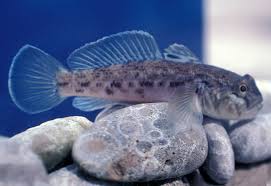
The long term effects of round goby in Lake Erie are still unknown. Image: Michigan Sea Grant
By Eric Freedman
Capital News Service
The round goby is one of the nastiest aliens in the Great Lakes — with what the Michigan Department of Natural Resources (DNR) calls its “voracious appetite and an aggressive nature which allows them to dominate over native species.”
But smallmouth bass find them yummy chow, and that’s also good news for crayfish that used to top the smallmouth bass menu.
“Changes in growth seem to be occurring to the greatest extent with the youngest bass,” said Derek Crane, a fisheries biologist who works with Lake Superior State University’s Aquatic Research Laboratory. Female growth increased more than male growth.
Those findings likely apply throughout the Great Lakes, Crane said.
Crane, who teaches at Carolina Coastal University in South Carolina, is the co-author of a new study of changes in the diet and growth of smallmouth bass since the round goby invaded eastern Lake Erie. The other author, Donald Einhouse, is with the New York Department of Environmental Conservation’s Lake Erie Fisheries Unit.
Following its invasion of Lake Erie, the shallowest of the five Great Lakes, the round goby “quickly became the dominant prey item of smallmouth bass.” replacing crayfish, the study said.
“Invasive species can have substantial effects on population characteristics and life histories of native fauna,” the study said. It appeared online in the Journal of Great Lakes Research.
Scientists first identified the round goby in 1990 in the St. Clair River. Since then it’s become “one of the most successful invaders of the Great Lakes and its tributaries,” the study said. Its arrival is blamed on ballast water.
According to DNR, the round goby holds “a competitive advantage over native species due to a well-developed sensory system that allows for enhanced water movement detection and the ability to feed in complete darkness.”
A DNR invasive species alert notes that it “can spawn multiple times in a single season,” And the new study notes that it can “successfully occupy a variety of habits” that have different temperatures, salinity and levels of dissolved oxygen.
Although the round goby is responsible for a “decreased abundance” of some bottom-dwelling Great Lakes native species, the study said other species have benefited, in addition to smallmouth bass.
Crane said the beneficiaries include burbot and the Lake Erie water snake, both of which dine on the round goby.
And DNR says that in Lake Michigan, the round goby population “has skyrocketed, and they are now being eaten by almost every predator except Chinook salmon.”
But the situation isn’t all rosy for smallmouth bass. That’s because the round goby feeds on smallmouth bass eggs, the study said.
It noted that resource managers examine fish growth to evaluate the productivity of bodies of water and to assess fish management practices.
More research is needed to explore such questions as “ecological trade-offs” and the long-term implications of changes in how long smallmouth bass live, it said.
Couldn’t we have fish hatcheries work on replenish small and large mouth bass, perch, pike, and Muskie fish? If the states and Canada along the Great Lakes and st. Lawrence River work together to up the goby predators would the goby population decline? What eats goby’s eggs?
this is horrible information. trump is trump.
From Miguel Moncada